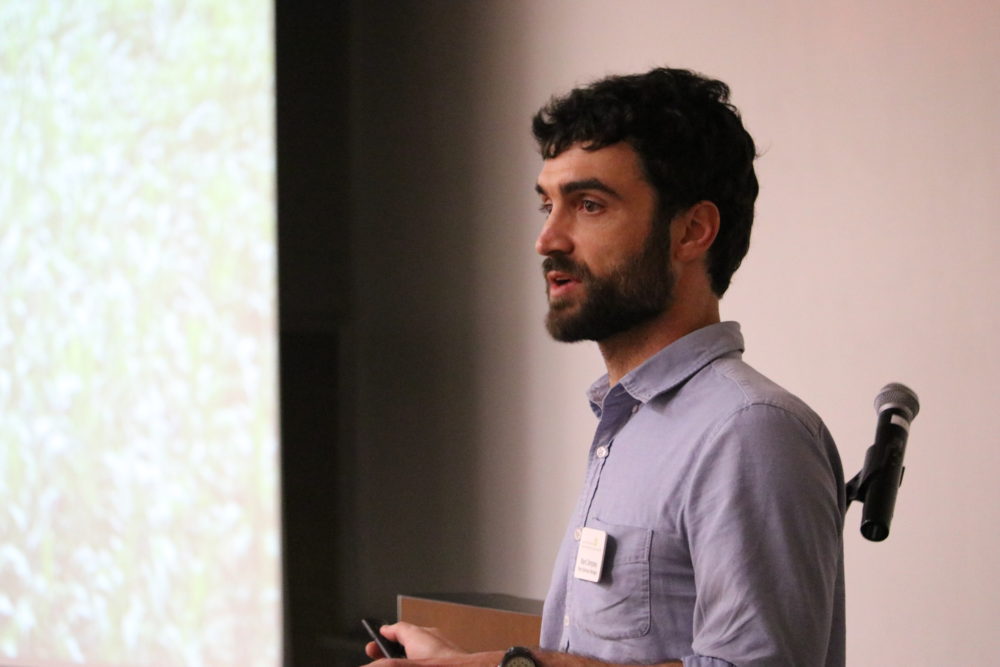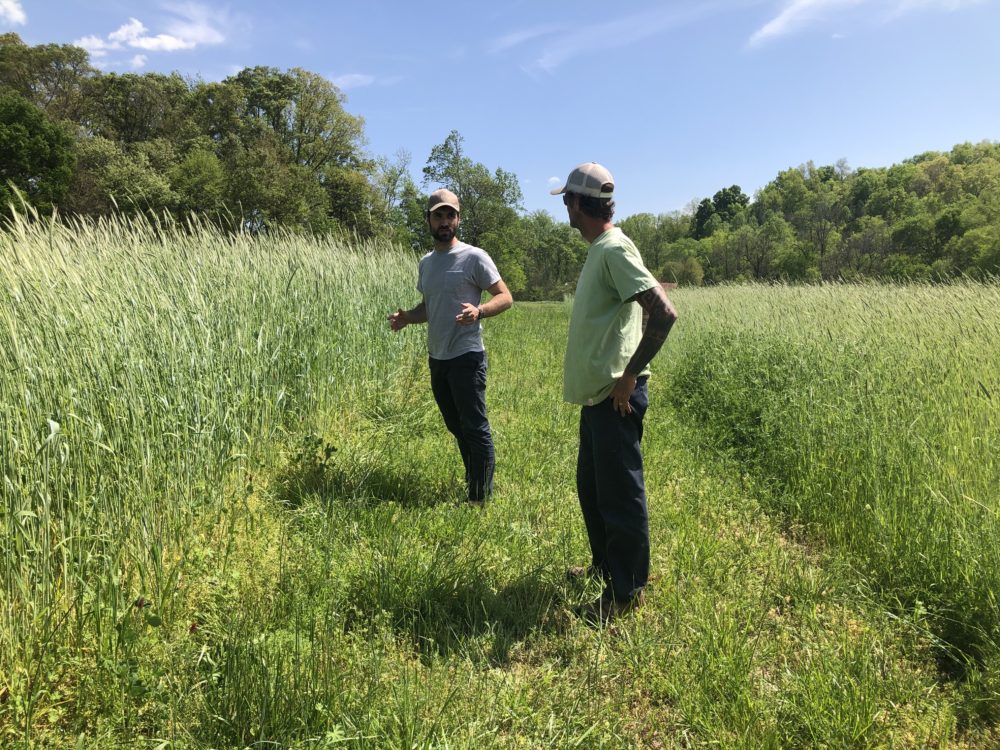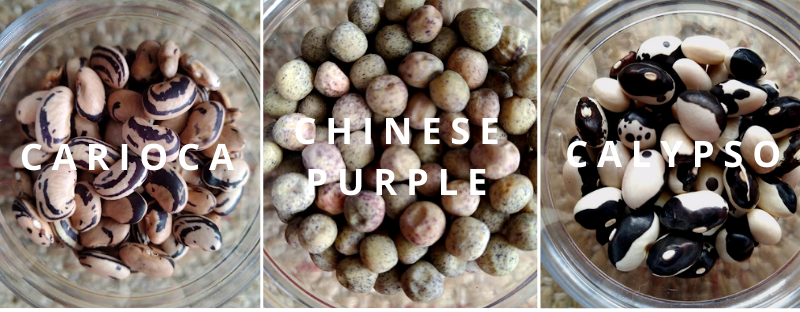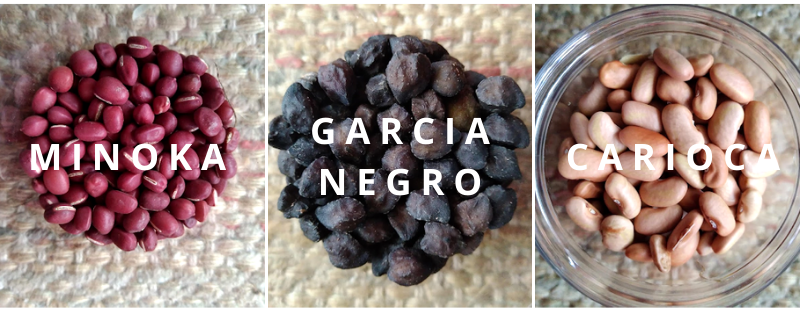by Ashley See, CFSA Communications Coordinator | Monday, Aug. 10, 2020 –

Here at CFSA, we’ve been wanting to give readers an opportunity to get to know our staff better. Beyond job titles and duties, what interests, passions, and hobbies do the staff of the Carolina Farm Stewardship Association have?
For this inaugural post in the series, we’re introducing Mark Dempsey, CFSA Farm Services Manager. As one of our two staff members in Asheville, North Carolina, Mark provides one-on-one consulting to farmers looking to transition their farms to certified organic. He also writes Conservation Activity Plans, which help farmers who are interested in transitioning to organic production by addressing the natural resource concerns on their farm. In between helping farmers directly, Mark can be found conducting research and collecting data at various farms across western North Carolina (including our very own Lomax Farm).
Now that you’re loosely acquainted, we’ll hand it over to Mark.
Tell us your food story. What brought you to local food and farming?
Mark: That’s an interesting question because I didn’t grow up farming, and, unfortunately, didn’t grow up with much food culture to speak of. My access point to food and farming was first as a cook at a vegetarian restaurant, where I learned to love good food. My second access point was as a student of environmental science, where I came to appreciate the complexity of environmental and economic issues faced by farmers. Through that lens, and especially while working in grain farming for five years, it became clear there was a lot of work to do in sustainable agriculture.
You’ve been at CFSA since late 2016. What are some of the duties of your position that delight you the most?
Mark: Overall, my hope is to advance sustainable ag by helping farmers directly via one-on-one consulting, but also by helping solve problems and answer bigger questions through CFSA’s research program. It’s a real privilege to be able to create knowledge through research, and while I love doing that, the real gold for me is in helping farmers directly.
When you’re not writing Conservation Activity Plans or helping folks with organic certification, what does life outside of CFSA look like?
Mark: When I can squeeze free time out of a day, my favorite things to do include working in the garden, making furniture in my woodshop, running, building small-scale farm equipment to make gardening easier, and spending time with my sweetie, friends, and family.
 Mark’s 3,000 square-foot garden situated in downtown Swannanoa, NC grows beans, corn, wheat, and a few vegetable crops. This year’s experimental crops, grown in collaboration with Chris Smith of the Utopian Seed Project, include peanuts, sorghum, a tasty okra variety (“Puerto Rican Evergreen”), and 12 sweet potato varieties.
Mark’s 3,000 square-foot garden situated in downtown Swannanoa, NC grows beans, corn, wheat, and a few vegetable crops. This year’s experimental crops, grown in collaboration with Chris Smith of the Utopian Seed Project, include peanuts, sorghum, a tasty okra variety (“Puerto Rican Evergreen”), and 12 sweet potato varieties.
As a trained soil scientist and cover crop specialist, you give a lot of talks on these topics. What’s one thing that gardeners and farmers focus too much on when it comes to understanding soil health, and what is overlooked?
Mark: When most folks talk about building soil health, they tend to focus on reducing tillage and building organic matter. Both are great, of course, with organic matter at the top of the list for anyone growing in degraded clay or sandy soils; however, what’s often overlooked is having living plants in the ground as often as possible—the goal is 24 hours a day, seven days a week, 365 days a year.
Materials like compost, manure, and various mulches are easy to apply and can add tons of organic matter to the soil. The important distinction is that those materials mostly feed decomposer organisms (that breakdown organic matter and release nutrients) and do little to feed the organisms that live symbiotically with crops and contribute much to the crop’s ability to access water and nutrients as well as resist pest pressure. In particular, it appears to be important to maximize plant growth over the course of the year but to not harvest all of it. You should have at least one cover crop every year (one or two cash crops, rarely more, harvested per year) to reap the full benefit for soil health and long term soil fertility. There’s a wonderful, steadily growing body of research to support these ideas, but is still gaining traction and hasn’t been put into universal practice.
“What’s often overlooked is having living plants in the ground as often as possible—the goal is 24 hours a day, seven days a week, 365 days a year.”
To be clear, both approaches—adding organic matter-rich materials and prioritizing living plants in the ground as often as possible—should indeed be used to build soil health and organic matter. I’m emphasizing living plants to highlight the fact that this approach is often overlooked. If you’re a grower with a stubborn soil fertility situation or low organic matter problem, and you haven’t yet tried this approach, I suggest you consider it—the countless plant-microbe relationships may be able to help correct these issues.

Mark and Dylan, Lomax Farm Coordinator, survey the cover crop for a no-till research project
at Lomax Farm in Concord, NC
We all have something we’re hyper nerdy for. A little birdy told us that you love growing beans. Why beans? Where does this love come from and how is it currently cropping up in your garden?
Mark: Beans, dry beans in particular, and the seeds of so many other legumes we eat are truly remarkable. I’m only half kidding when I say that they’re going to save the world. My love for beans is three-fold: their amazing role in cropping systems, their positive effects on human health and nutrition, and their wonderful culinary value.
Dry beans and the like are nutrient-dense crops that store well and can be grown on any scale—making them valuable to the gardener and the grain farmer—and will almost certainly play an important role in feeding our ballooning population in the future. They are the most land-efficient way to grow protein, and because of their symbiotic relationship with bacteria in their roots, they require little to no nitrogen fertilizer—making them a relatively low maintenance crop with obvious environmental and financial benefits. Eating legumes is associated with myriad health benefits that need not be listed here, and there are so many kinds, flavors, and dishes that can be made from them on the cheap (money, time, acreage, etc.) and with little effort. I find them to be the most versatile food in my kitchen, making it into most meals each day. Not to mention that many of them are quite beautiful and can fetch a good price at the market.
My love for beans is three-fold: their amazing role in cropping systems, their positive effects on human health and nutrition, and their wonderful culinary value.
What’s currently growing in the garden? Well, it took me a while to narrow it down, but after the last 10 or so years trialing different species and varieties, I found a few I like enough to dedicate a lot of space to.
- My spring legumes include several pea varieties (allowed to go to seed for cooking and eating), black chickpeas, and french lentils—all of which were harvested in June and July.
- My summer legumes typically include one or two heirloom varieties, two cowpea varieties (one blue and one red), an adzuki bean, a black soybean with 40% protein, and two Swannanoa, NC-bred dry bean varieties that I’ve been selecting since 2015. Both of the Swannanoa beans are quite delicious—one selected for its pretty appearance, the other for its good behavior (i.e., a bush habit and uniform maturity). I’m also trying peanuts for the first time this year.
A slice of legume diversity grown in Swannanoa, NC.
Clockwise from top-left: Swannanoa-bred purple striped bean (“Carioca” offshoot); a colorful spring pea (“Chinese Purple”); a black and white heirloom bean (“Calypso”); a beige Swannanoa bean with subtle yellow striping (“Carioca” offshoot); black chickpea (“Garcia Negro”); adzuki bean (“Minoka”).
If you could have a farm anywhere and only eat and grow three crops (ignoring all practicality!) where would it be and what would you grow?
Mark: I love where I am in western North Carolina! While I wouldn’t mind more growing space to increase production and have a bean-focused side hustle, my small lot is good for now.
While I would surely wither away, emotionally and physically, if I could only grow and eat three crops, the choice for me is surprisingly easy: beans, sweet potatoes, and peaches. Beans and sweet potatoes are more practical choices and reflect my love of storage crops. The peaches are for indulgence.
What are you reading right now and what recipe are you obsessed with?
Mark: I enjoy fiction more than nonfiction but these days my time spent in books is split between Isabel Allende’s The House of the Spirits for fun and Weeds of the South (Charles T. Bryson & Michael S. DeFelice) to sort out which weeds are troubling our research project this year.
As for recipes, I sometimes wish I was a recipe person but must admit that I only use them when baking. Maybe it’s time to turn some of my zucchini into bread!
Given the choice of anyone in the world, who would you want as a dinner guest?
Mark: Easy: Mary Oliver
Lastly, what do you wish folks in the food and farming community discussed more?
Mark: Social injustice in the food system, with racism and sexism standing out most prominently. I have certainly witnessed these injustices firsthand and more often have seen the ways in which these injustices are felt and reinforced throughout the food system—from subtle or unintentional to overtly prejudiced. And, of course, there are many other injustices within the food system that should be named, examined, and pushed against just like any other. My hope is that by discussing these issues we can begin to face them, and work toward cultural, structural, and power shifts that aim to end injustice, prejudice, and oppression.
Whether you love beans as much as Mark does, have a question, or just want to say hello, Mark can be reached at mark@carolinafarmstewards.org.




